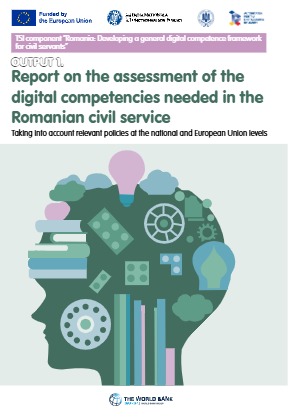Last Edited: 5 months ago
Report on the assessment of the digital competencies needed in the Romanian civil serviceFebruary 2025
Taking into account relevant policies at the national and European Union levels
Romania’s public administration faces deep-rooted structural challenges that hinder the development of digital competencies and slow progress in both digital transformation and human resources management (HRM) reforms. While digital competencies are essential to achieving Romania’s public sector modernization goals, they are not a standalone solution. In this context, the government of Romania, assisted by the World Bank through the Technical Support Instrument (TSI), aims to develop a General Digital Competence Framework for Civil Servants.
This report if one of the outputs of the TSI project; its goal is to identify the digital competencies necessary at the intersection of Romania’s digital transformation and HRM reform agendas, laying the groundwork for a more capable and future-ready public administration. The report employs a comprehensive multi-layered analysis, incorporating: a top-down review of national and EU strategies, policies, and regulations; a bottom-up analysis of job descriptions, focus groups, interviews, and working groups; international best practices in public sector digital competencies; and a foresight perspective to anticipate future digital skill needs.
Chapter VI | Foresight: fit-for-future digital roles in the public administration describes the foresight exercise carried out by Institutul de Prospectiva and the World Bank, which was aimed at ensuring that the proposed digital competency framework will remain future-ready, enabling civil servants to navigate digital transformation, deliver citizen-centric services, and address complex policy challenges with agility and innovation. The process was meant to inform the definition of specific digital roles that are needed in the future, but also to allow the formulation of recommendations regarding the general digital competencies of public administration employees.
The foresight methodology utilized horizon scanning and scenarios (both explorative and normative), as essential tools in helping policymakers navigate uncertainty by exploring various probable and/or desirable futures. This foresight exercise focused on the year 2032, a timeframe suited for significant structural transformation in public administration, allowing for the development and maturity of complex digital systems.
In terms of process, the scenario-building process was based on an iterative consultation process. It built on inputs developed by the foresight team from Institutul de Prospectiva and was progressively refined through three online working sessions with international experts from the World Bank and the Joint Research Centre (JRC) and a final in-person workshop with local experts from the public administration and the private sector in Romania.
The figure below provides a concise overview of the scenario-building steps.
📌The Baseline Scenario “Romanian Digital Administration in 2032” provides a ‘current paradigm’ case: It takes the current Romanian strategic documents in the field of digital transformation as a starting point. It assumes that the key goals set in these
documents are generally met by 2032. The logic is the following: assuming Romania’s current digitalization paradigm (and
associated digital roles) turn out mostly as planned, what is the gap between this best-case baseline and the digital society scenarios for 2032?
📌The Context Scenario about the “Digital society in Romania in 2032” is an exploratory scenario, meaning it describes a probable future rather than one driven by a deliberate vision of a desirable future society. The core scenario integrates high-impact, high-probability trends - or drivers of change -identified in the initial horizon scanning phase. While these drivers describe the evolution of the European and global contexts, their advancement has been partially adjusted to reflect specific conditions in Romania. In addition to the core scenario, four other narratives were built around drivers of change previously identified as having high impact as well as a rather high degree of uncertainty. These new dimensions largely complement rather than challenge the core scenario.
📌The five Aspirational Scenarios 2032 describe visions regarding the digital transformation of the Romanian public administration, going beyond the trajectory set in the baseline scenario. They examine a range of potential paths/options that could contribute, individually or in various combinations, to a more ambitious and impactful digital transformation in the public administration. Each scenario revolves around a key dimension. Primarily, these dimensions emerge from Romania’s current policy discourse and strategic documents, where they are often mentioned but with limited precision or commitment. Additionally, they reflect elements of the context scenario, incorporating anticipated societal developments by 2032, as
well as digital trends and paradigm shifts observed in public administrations in the EU and worldwide.
A list of key digital roles follows the baseline and aspirational scenarios, outlining the expertise civil servants need to bring them to life. These roles do not distinguish between in-house and outsourced expertise, as that remains a separate decision.
Posted on: 11/08/2025



